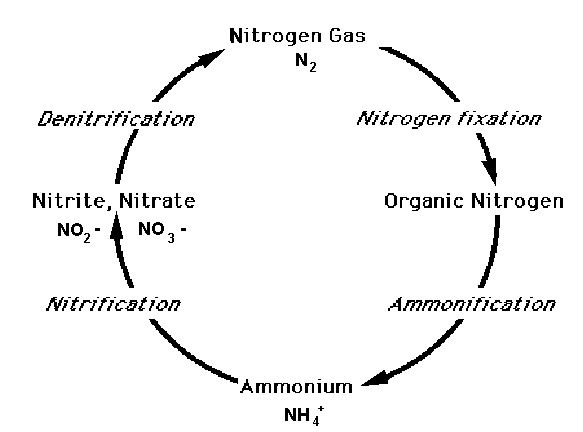see animations below:
- learn the names of each step and what happens here
- note what happens in each step
Now practice drawing the cycle on your own
How did you with this simple version?
Let's try drawing option number 2
How did you do with this one?
Let's wrap it up with a complete cycle
Microbes are involved at most stages of the nitrogen cycle:
Nitrogen Fixation. 78% of the atmosphere is nitrogen gas (N2), but this is inert and can’t be used by plants or animals. Nitrogen fixing bacteria reduce nitrogen gas to ammonia (N2 + 6H g 2NH3), which dissolves to form ammonium ions (NH4+ ). This process uses the enzyme nitrogenase and ATP as a source of energy. The nitrogen-fixing bacteria may be free-living in soil or water, or they may live in colonies inside the cells of root nodules of leguminous plants such as clover or peas. This is an example of mutualism as the plants gain a source of useful nitrogen from the bacteria, while the bacteria gain carbohydrates and protection from the plants. Nitrogen gas can also be fixed to ammonia by humans using the Haber process, and a small amount of nitrogen is fixed to nitrate by lightning.
Nitrification. Nitrifying bacteria can oxidise ammonia to nitrate in two stages: first forming nitrite ions NH4+gNO-2 then forming nitrate ions NO-2gNO-3. These are chemosynthetic bacteria, which means they use the energy released by nitrification to live, instead of using respiration. Plants can only take up nitrogen in the form of nitrate.
Denitrification. The anaerobic denitrifying bacteria convert nitrate to N2 and NOx, which is then lost to the air. This represents a constant loss of “useful” nitrogen from soil, and explains why nitrogen fixation by the nitrifying bacteria and fertilisers are so important.
Ammonification. Microbial saprophytes break down proteins in detritus to form ammonia in two stages: first they digest proteins to amino acids using extracellular protease enzymes, then they remove the amino groups from amino acids using deaminase enzymes.



thank you. i have a final tomorrow and this was helpful :)
ReplyDelete